Investigating Social Networking in Wesfarmers: A Research Project
VerifiedAdded on 2023/06/13
|10
|3137
|428
Project
AI Summary
This research project investigates the advantages and disadvantages of using social networking within Wesfarmers Limited, a company operating in diverse sectors like chemicals, retail, and manufacturing. The study highlights various marketing strategies employed through social networking and their impact on Wesfarmers, addressing issues such as cyber security and brand image. The research employs quantitative data collection methods, following Saunders' research onion framework, which includes research philosophy (positivism), approach (deductive), strategy (survey and systematic literature review), design (descriptive), and choice (mono method, quantitative). Primary data is gathered through questionnaires distributed to 40 Wesfarmers employees, while secondary data is collected from books, journals, and company websites. The analysis uses frequency distribution to assess the relevance of the collected numerical data, ensuring ethical research practices and maintaining reliability and validity throughout the investigation. Desklib provides access to this project and other study resources for students.
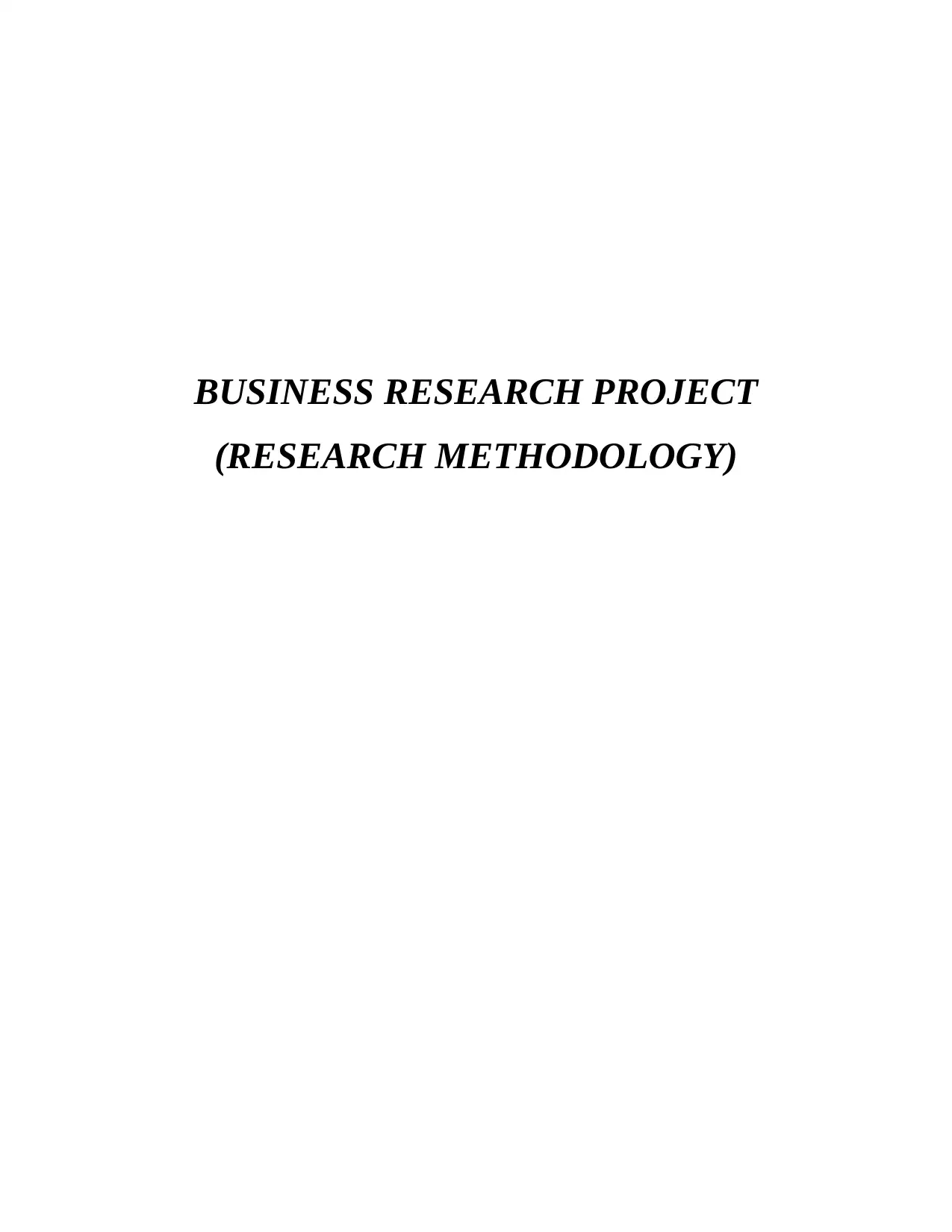
BUSINESS RESEARCH PROJECT
(RESEARCH METHODOLOGY)
(RESEARCH METHODOLOGY)
Paraphrase This Document
Need a fresh take? Get an instant paraphrase of this document with our AI Paraphraser
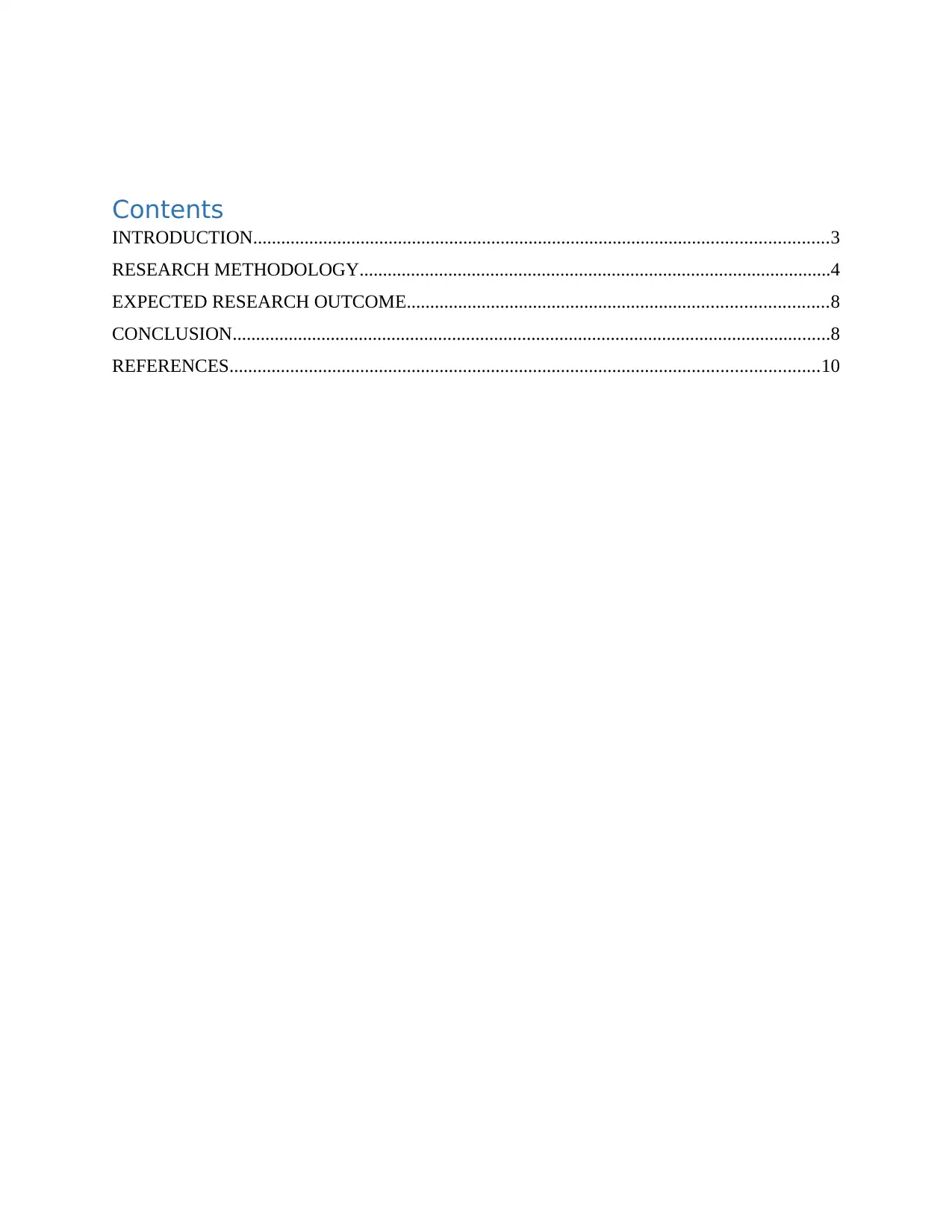
Contents
INTRODUCTION...........................................................................................................................3
RESEARCH METHODOLOGY.....................................................................................................4
EXPECTED RESEARCH OUTCOME..........................................................................................8
CONCLUSION................................................................................................................................8
REFERENCES..............................................................................................................................10
INTRODUCTION...........................................................................................................................3
RESEARCH METHODOLOGY.....................................................................................................4
EXPECTED RESEARCH OUTCOME..........................................................................................8
CONCLUSION................................................................................................................................8
REFERENCES..............................................................................................................................10
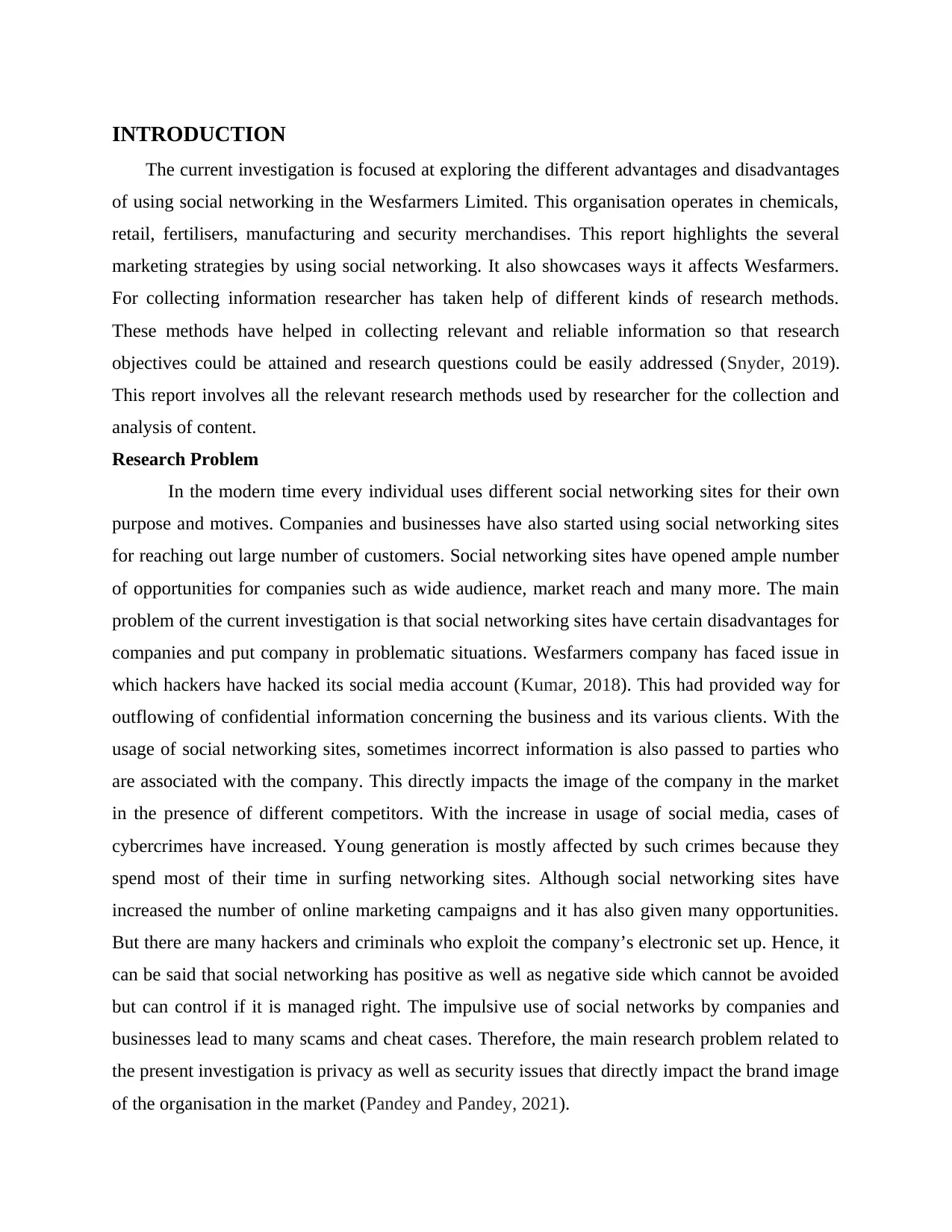
INTRODUCTION
The current investigation is focused at exploring the different advantages and disadvantages
of using social networking in the Wesfarmers Limited. This organisation operates in chemicals,
retail, fertilisers, manufacturing and security merchandises. This report highlights the several
marketing strategies by using social networking. It also showcases ways it affects Wesfarmers.
For collecting information researcher has taken help of different kinds of research methods.
These methods have helped in collecting relevant and reliable information so that research
objectives could be attained and research questions could be easily addressed (Snyder, 2019).
This report involves all the relevant research methods used by researcher for the collection and
analysis of content.
Research Problem
In the modern time every individual uses different social networking sites for their own
purpose and motives. Companies and businesses have also started using social networking sites
for reaching out large number of customers. Social networking sites have opened ample number
of opportunities for companies such as wide audience, market reach and many more. The main
problem of the current investigation is that social networking sites have certain disadvantages for
companies and put company in problematic situations. Wesfarmers company has faced issue in
which hackers have hacked its social media account (Kumar, 2018). This had provided way for
outflowing of confidential information concerning the business and its various clients. With the
usage of social networking sites, sometimes incorrect information is also passed to parties who
are associated with the company. This directly impacts the image of the company in the market
in the presence of different competitors. With the increase in usage of social media, cases of
cybercrimes have increased. Young generation is mostly affected by such crimes because they
spend most of their time in surfing networking sites. Although social networking sites have
increased the number of online marketing campaigns and it has also given many opportunities.
But there are many hackers and criminals who exploit the company’s electronic set up. Hence, it
can be said that social networking has positive as well as negative side which cannot be avoided
but can control if it is managed right. The impulsive use of social networks by companies and
businesses lead to many scams and cheat cases. Therefore, the main research problem related to
the present investigation is privacy as well as security issues that directly impact the brand image
of the organisation in the market (Pandey and Pandey, 2021).
The current investigation is focused at exploring the different advantages and disadvantages
of using social networking in the Wesfarmers Limited. This organisation operates in chemicals,
retail, fertilisers, manufacturing and security merchandises. This report highlights the several
marketing strategies by using social networking. It also showcases ways it affects Wesfarmers.
For collecting information researcher has taken help of different kinds of research methods.
These methods have helped in collecting relevant and reliable information so that research
objectives could be attained and research questions could be easily addressed (Snyder, 2019).
This report involves all the relevant research methods used by researcher for the collection and
analysis of content.
Research Problem
In the modern time every individual uses different social networking sites for their own
purpose and motives. Companies and businesses have also started using social networking sites
for reaching out large number of customers. Social networking sites have opened ample number
of opportunities for companies such as wide audience, market reach and many more. The main
problem of the current investigation is that social networking sites have certain disadvantages for
companies and put company in problematic situations. Wesfarmers company has faced issue in
which hackers have hacked its social media account (Kumar, 2018). This had provided way for
outflowing of confidential information concerning the business and its various clients. With the
usage of social networking sites, sometimes incorrect information is also passed to parties who
are associated with the company. This directly impacts the image of the company in the market
in the presence of different competitors. With the increase in usage of social media, cases of
cybercrimes have increased. Young generation is mostly affected by such crimes because they
spend most of their time in surfing networking sites. Although social networking sites have
increased the number of online marketing campaigns and it has also given many opportunities.
But there are many hackers and criminals who exploit the company’s electronic set up. Hence, it
can be said that social networking has positive as well as negative side which cannot be avoided
but can control if it is managed right. The impulsive use of social networks by companies and
businesses lead to many scams and cheat cases. Therefore, the main research problem related to
the present investigation is privacy as well as security issues that directly impact the brand image
of the organisation in the market (Pandey and Pandey, 2021).
⊘ This is a preview!⊘
Do you want full access?
Subscribe today to unlock all pages.

Trusted by 1+ million students worldwide

Research Question
The main question of the current research is to determine the benefits and drawbacks of
using social network within Wesfarmers. This research question is addressed with the help of
different thoughts of authors and researchers. This basically takes help of different sources of
primary and secondary method so that in-depth information can be easily gathered. This question
assists in highlighting the dark side as well as positive side for companies. This question is
directly linked to the identified research problem so that different opinions can be collected
related to the topic.
The main research question is “What are the benefits and drawbacks of utilising social
networking within Wesfarmers?”
RESEARCH METHODOLOGY
Research methodology is the vital part of the investigation because it helps in the collection
and evaluation of content. This takes help of various research approaches, techniques and
methods so that defined objectives and questions could be easily attained. It shows a systematic
research that includes identification of research problem, formation of research questions,
accumulation of data and many more. For accumulating information about advantages and
disadvantages of social networks within an organisation, quantitative data is gathered so that
research questions could be easily addressed. There are different types of quantitative research
techniques which have been used by investigator (Babii, 2020). Saunders research onion
framework is followed which includes different layers of different research methods. This
framework was introduced by Saunders, Thornhill and Lewis in the book titled as research
methods for business students. The major purpose of research methodologies is to gain
familiarity and attain newer insights in relation to a specific topic. The sources considered in the
current research hold vital place because they assist in the collection of primary as well as
secondary piece of information. All the used methodologies are given below with their apt
justification.
Research Philosophy: It is the first layer of the research onion framework which provides set of
principles and beliefs that help researcher in the process of collecting, analysing and interpreting
information systematically. The philosophy is commonly studied in the type of epistemology,
axiology and ontology. Researcher has relied upon epistemology philosophy as it helps in
introducing with great piece of information. This is further categorised in two types that are:
The main question of the current research is to determine the benefits and drawbacks of
using social network within Wesfarmers. This research question is addressed with the help of
different thoughts of authors and researchers. This basically takes help of different sources of
primary and secondary method so that in-depth information can be easily gathered. This question
assists in highlighting the dark side as well as positive side for companies. This question is
directly linked to the identified research problem so that different opinions can be collected
related to the topic.
The main research question is “What are the benefits and drawbacks of utilising social
networking within Wesfarmers?”
RESEARCH METHODOLOGY
Research methodology is the vital part of the investigation because it helps in the collection
and evaluation of content. This takes help of various research approaches, techniques and
methods so that defined objectives and questions could be easily attained. It shows a systematic
research that includes identification of research problem, formation of research questions,
accumulation of data and many more. For accumulating information about advantages and
disadvantages of social networks within an organisation, quantitative data is gathered so that
research questions could be easily addressed. There are different types of quantitative research
techniques which have been used by investigator (Babii, 2020). Saunders research onion
framework is followed which includes different layers of different research methods. This
framework was introduced by Saunders, Thornhill and Lewis in the book titled as research
methods for business students. The major purpose of research methodologies is to gain
familiarity and attain newer insights in relation to a specific topic. The sources considered in the
current research hold vital place because they assist in the collection of primary as well as
secondary piece of information. All the used methodologies are given below with their apt
justification.
Research Philosophy: It is the first layer of the research onion framework which provides set of
principles and beliefs that help researcher in the process of collecting, analysing and interpreting
information systematically. The philosophy is commonly studied in the type of epistemology,
axiology and ontology. Researcher has relied upon epistemology philosophy as it helps in
introducing with great piece of information. This is further categorised in two types that are:
Paraphrase This Document
Need a fresh take? Get an instant paraphrase of this document with our AI Paraphraser
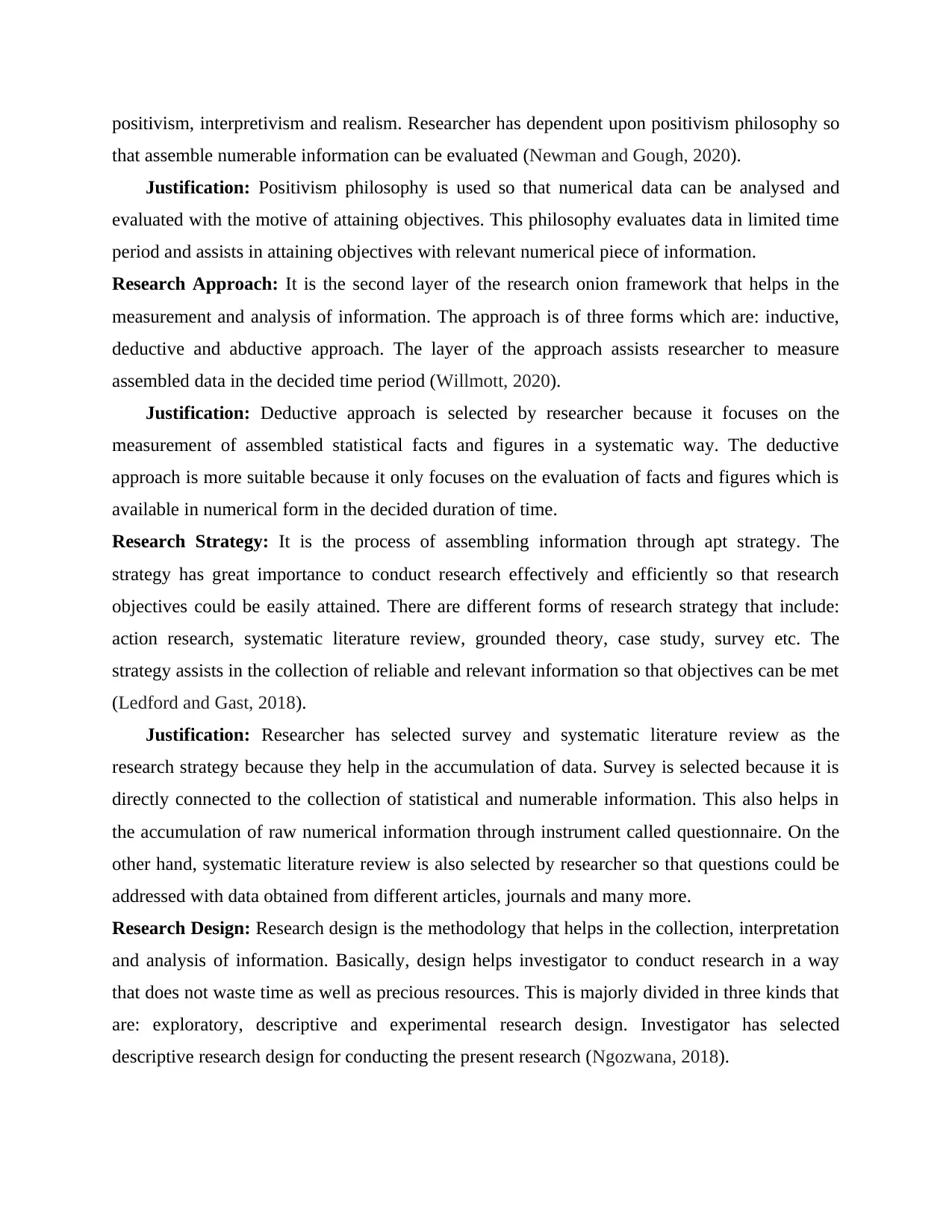
positivism, interpretivism and realism. Researcher has dependent upon positivism philosophy so
that assemble numerable information can be evaluated (Newman and Gough, 2020).
Justification: Positivism philosophy is used so that numerical data can be analysed and
evaluated with the motive of attaining objectives. This philosophy evaluates data in limited time
period and assists in attaining objectives with relevant numerical piece of information.
Research Approach: It is the second layer of the research onion framework that helps in the
measurement and analysis of information. The approach is of three forms which are: inductive,
deductive and abductive approach. The layer of the approach assists researcher to measure
assembled data in the decided time period (Willmott, 2020).
Justification: Deductive approach is selected by researcher because it focuses on the
measurement of assembled statistical facts and figures in a systematic way. The deductive
approach is more suitable because it only focuses on the evaluation of facts and figures which is
available in numerical form in the decided duration of time.
Research Strategy: It is the process of assembling information through apt strategy. The
strategy has great importance to conduct research effectively and efficiently so that research
objectives could be easily attained. There are different forms of research strategy that include:
action research, systematic literature review, grounded theory, case study, survey etc. The
strategy assists in the collection of reliable and relevant information so that objectives can be met
(Ledford and Gast, 2018).
Justification: Researcher has selected survey and systematic literature review as the
research strategy because they help in the accumulation of data. Survey is selected because it is
directly connected to the collection of statistical and numerable information. This also helps in
the accumulation of raw numerical information through instrument called questionnaire. On the
other hand, systematic literature review is also selected by researcher so that questions could be
addressed with data obtained from different articles, journals and many more.
Research Design: Research design is the methodology that helps in the collection, interpretation
and analysis of information. Basically, design helps investigator to conduct research in a way
that does not waste time as well as precious resources. This is majorly divided in three kinds that
are: exploratory, descriptive and experimental research design. Investigator has selected
descriptive research design for conducting the present research (Ngozwana, 2018).
that assemble numerable information can be evaluated (Newman and Gough, 2020).
Justification: Positivism philosophy is used so that numerical data can be analysed and
evaluated with the motive of attaining objectives. This philosophy evaluates data in limited time
period and assists in attaining objectives with relevant numerical piece of information.
Research Approach: It is the second layer of the research onion framework that helps in the
measurement and analysis of information. The approach is of three forms which are: inductive,
deductive and abductive approach. The layer of the approach assists researcher to measure
assembled data in the decided time period (Willmott, 2020).
Justification: Deductive approach is selected by researcher because it focuses on the
measurement of assembled statistical facts and figures in a systematic way. The deductive
approach is more suitable because it only focuses on the evaluation of facts and figures which is
available in numerical form in the decided duration of time.
Research Strategy: It is the process of assembling information through apt strategy. The
strategy has great importance to conduct research effectively and efficiently so that research
objectives could be easily attained. There are different forms of research strategy that include:
action research, systematic literature review, grounded theory, case study, survey etc. The
strategy assists in the collection of reliable and relevant information so that objectives can be met
(Ledford and Gast, 2018).
Justification: Researcher has selected survey and systematic literature review as the
research strategy because they help in the accumulation of data. Survey is selected because it is
directly connected to the collection of statistical and numerable information. This also helps in
the accumulation of raw numerical information through instrument called questionnaire. On the
other hand, systematic literature review is also selected by researcher so that questions could be
addressed with data obtained from different articles, journals and many more.
Research Design: Research design is the methodology that helps in the collection, interpretation
and analysis of information. Basically, design helps investigator to conduct research in a way
that does not waste time as well as precious resources. This is majorly divided in three kinds that
are: exploratory, descriptive and experimental research design. Investigator has selected
descriptive research design for conducting the present research (Ngozwana, 2018).
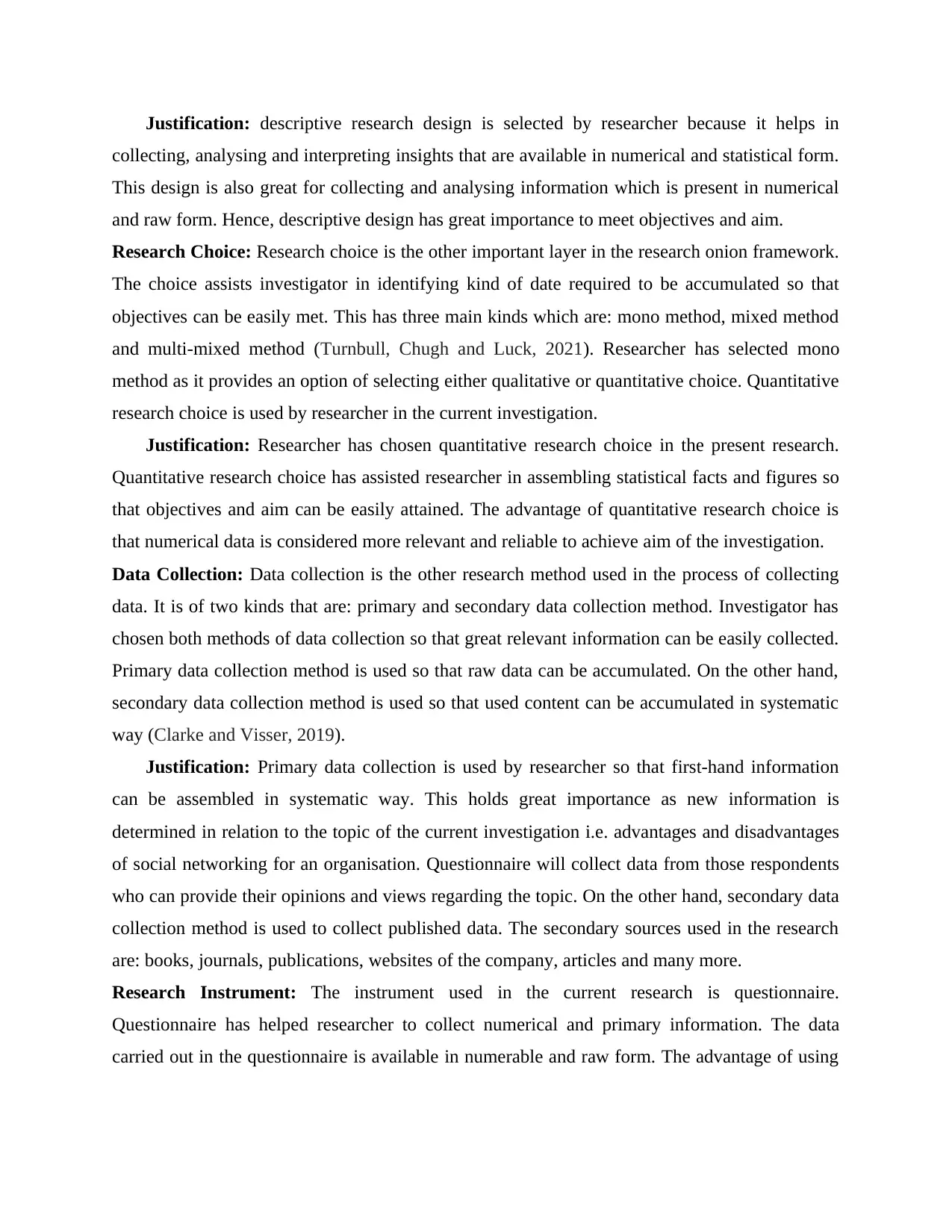
Justification: descriptive research design is selected by researcher because it helps in
collecting, analysing and interpreting insights that are available in numerical and statistical form.
This design is also great for collecting and analysing information which is present in numerical
and raw form. Hence, descriptive design has great importance to meet objectives and aim.
Research Choice: Research choice is the other important layer in the research onion framework.
The choice assists investigator in identifying kind of date required to be accumulated so that
objectives can be easily met. This has three main kinds which are: mono method, mixed method
and multi-mixed method (Turnbull, Chugh and Luck, 2021). Researcher has selected mono
method as it provides an option of selecting either qualitative or quantitative choice. Quantitative
research choice is used by researcher in the current investigation.
Justification: Researcher has chosen quantitative research choice in the present research.
Quantitative research choice has assisted researcher in assembling statistical facts and figures so
that objectives and aim can be easily attained. The advantage of quantitative research choice is
that numerical data is considered more relevant and reliable to achieve aim of the investigation.
Data Collection: Data collection is the other research method used in the process of collecting
data. It is of two kinds that are: primary and secondary data collection method. Investigator has
chosen both methods of data collection so that great relevant information can be easily collected.
Primary data collection method is used so that raw data can be accumulated. On the other hand,
secondary data collection method is used so that used content can be accumulated in systematic
way (Clarke and Visser, 2019).
Justification: Primary data collection is used by researcher so that first-hand information
can be assembled in systematic way. This holds great importance as new information is
determined in relation to the topic of the current investigation i.e. advantages and disadvantages
of social networking for an organisation. Questionnaire will collect data from those respondents
who can provide their opinions and views regarding the topic. On the other hand, secondary data
collection method is used to collect published data. The secondary sources used in the research
are: books, journals, publications, websites of the company, articles and many more.
Research Instrument: The instrument used in the current research is questionnaire.
Questionnaire has helped researcher to collect numerical and primary information. The data
carried out in the questionnaire is available in numerable and raw form. The advantage of using
collecting, analysing and interpreting insights that are available in numerical and statistical form.
This design is also great for collecting and analysing information which is present in numerical
and raw form. Hence, descriptive design has great importance to meet objectives and aim.
Research Choice: Research choice is the other important layer in the research onion framework.
The choice assists investigator in identifying kind of date required to be accumulated so that
objectives can be easily met. This has three main kinds which are: mono method, mixed method
and multi-mixed method (Turnbull, Chugh and Luck, 2021). Researcher has selected mono
method as it provides an option of selecting either qualitative or quantitative choice. Quantitative
research choice is used by researcher in the current investigation.
Justification: Researcher has chosen quantitative research choice in the present research.
Quantitative research choice has assisted researcher in assembling statistical facts and figures so
that objectives and aim can be easily attained. The advantage of quantitative research choice is
that numerical data is considered more relevant and reliable to achieve aim of the investigation.
Data Collection: Data collection is the other research method used in the process of collecting
data. It is of two kinds that are: primary and secondary data collection method. Investigator has
chosen both methods of data collection so that great relevant information can be easily collected.
Primary data collection method is used so that raw data can be accumulated. On the other hand,
secondary data collection method is used so that used content can be accumulated in systematic
way (Clarke and Visser, 2019).
Justification: Primary data collection is used by researcher so that first-hand information
can be assembled in systematic way. This holds great importance as new information is
determined in relation to the topic of the current investigation i.e. advantages and disadvantages
of social networking for an organisation. Questionnaire will collect data from those respondents
who can provide their opinions and views regarding the topic. On the other hand, secondary data
collection method is used to collect published data. The secondary sources used in the research
are: books, journals, publications, websites of the company, articles and many more.
Research Instrument: The instrument used in the current research is questionnaire.
Questionnaire has helped researcher to collect numerical and primary information. The data
carried out in the questionnaire is available in numerable and raw form. The advantage of using
⊘ This is a preview!⊘
Do you want full access?
Subscribe today to unlock all pages.

Trusted by 1+ million students worldwide
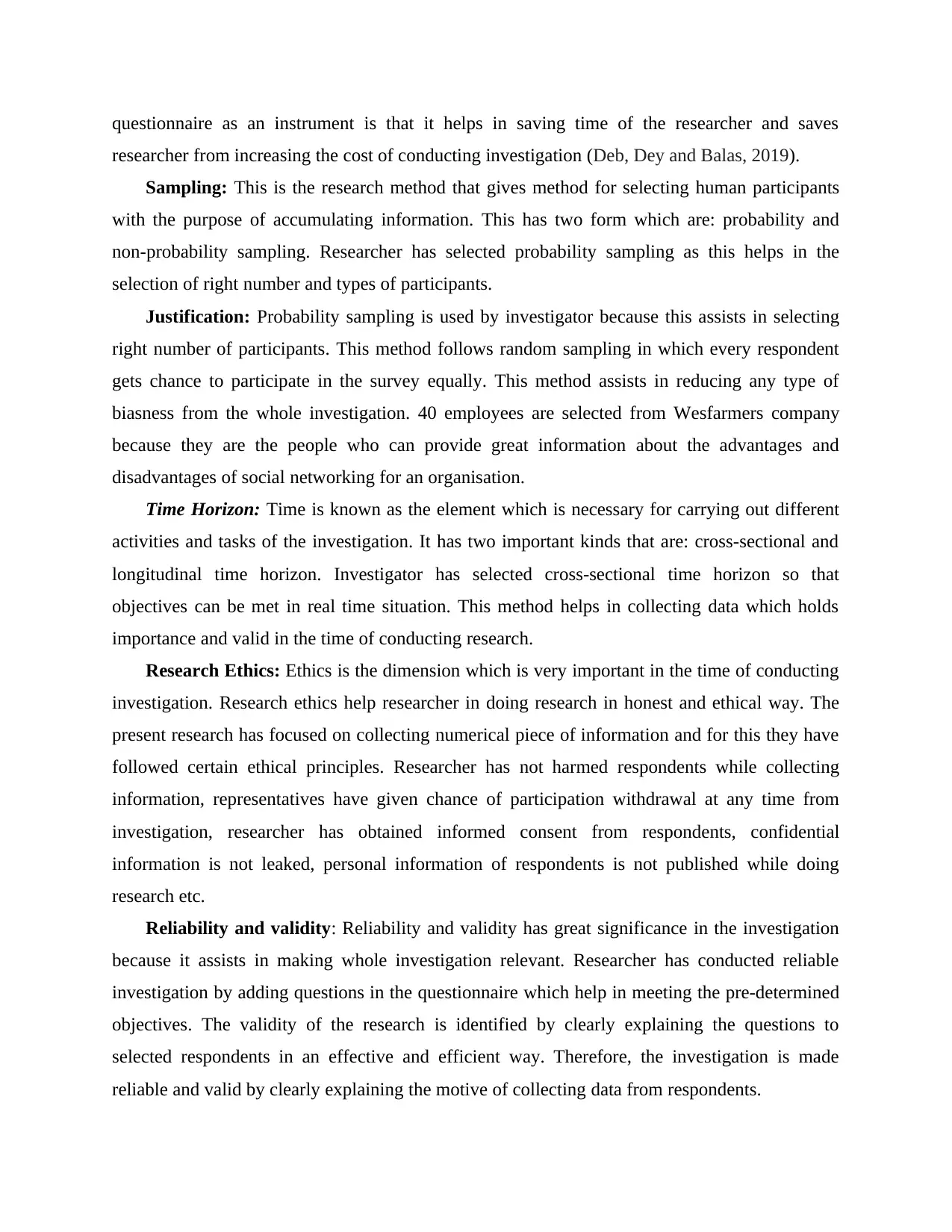
questionnaire as an instrument is that it helps in saving time of the researcher and saves
researcher from increasing the cost of conducting investigation (Deb, Dey and Balas, 2019).
Sampling: This is the research method that gives method for selecting human participants
with the purpose of accumulating information. This has two form which are: probability and
non-probability sampling. Researcher has selected probability sampling as this helps in the
selection of right number and types of participants.
Justification: Probability sampling is used by investigator because this assists in selecting
right number of participants. This method follows random sampling in which every respondent
gets chance to participate in the survey equally. This method assists in reducing any type of
biasness from the whole investigation. 40 employees are selected from Wesfarmers company
because they are the people who can provide great information about the advantages and
disadvantages of social networking for an organisation.
Time Horizon: Time is known as the element which is necessary for carrying out different
activities and tasks of the investigation. It has two important kinds that are: cross-sectional and
longitudinal time horizon. Investigator has selected cross-sectional time horizon so that
objectives can be met in real time situation. This method helps in collecting data which holds
importance and valid in the time of conducting research.
Research Ethics: Ethics is the dimension which is very important in the time of conducting
investigation. Research ethics help researcher in doing research in honest and ethical way. The
present research has focused on collecting numerical piece of information and for this they have
followed certain ethical principles. Researcher has not harmed respondents while collecting
information, representatives have given chance of participation withdrawal at any time from
investigation, researcher has obtained informed consent from respondents, confidential
information is not leaked, personal information of respondents is not published while doing
research etc.
Reliability and validity: Reliability and validity has great significance in the investigation
because it assists in making whole investigation relevant. Researcher has conducted reliable
investigation by adding questions in the questionnaire which help in meeting the pre-determined
objectives. The validity of the research is identified by clearly explaining the questions to
selected respondents in an effective and efficient way. Therefore, the investigation is made
reliable and valid by clearly explaining the motive of collecting data from respondents.
researcher from increasing the cost of conducting investigation (Deb, Dey and Balas, 2019).
Sampling: This is the research method that gives method for selecting human participants
with the purpose of accumulating information. This has two form which are: probability and
non-probability sampling. Researcher has selected probability sampling as this helps in the
selection of right number and types of participants.
Justification: Probability sampling is used by investigator because this assists in selecting
right number of participants. This method follows random sampling in which every respondent
gets chance to participate in the survey equally. This method assists in reducing any type of
biasness from the whole investigation. 40 employees are selected from Wesfarmers company
because they are the people who can provide great information about the advantages and
disadvantages of social networking for an organisation.
Time Horizon: Time is known as the element which is necessary for carrying out different
activities and tasks of the investigation. It has two important kinds that are: cross-sectional and
longitudinal time horizon. Investigator has selected cross-sectional time horizon so that
objectives can be met in real time situation. This method helps in collecting data which holds
importance and valid in the time of conducting research.
Research Ethics: Ethics is the dimension which is very important in the time of conducting
investigation. Research ethics help researcher in doing research in honest and ethical way. The
present research has focused on collecting numerical piece of information and for this they have
followed certain ethical principles. Researcher has not harmed respondents while collecting
information, representatives have given chance of participation withdrawal at any time from
investigation, researcher has obtained informed consent from respondents, confidential
information is not leaked, personal information of respondents is not published while doing
research etc.
Reliability and validity: Reliability and validity has great significance in the investigation
because it assists in making whole investigation relevant. Researcher has conducted reliable
investigation by adding questions in the questionnaire which help in meeting the pre-determined
objectives. The validity of the research is identified by clearly explaining the questions to
selected respondents in an effective and efficient way. Therefore, the investigation is made
reliable and valid by clearly explaining the motive of collecting data from respondents.
Paraphrase This Document
Need a fresh take? Get an instant paraphrase of this document with our AI Paraphraser
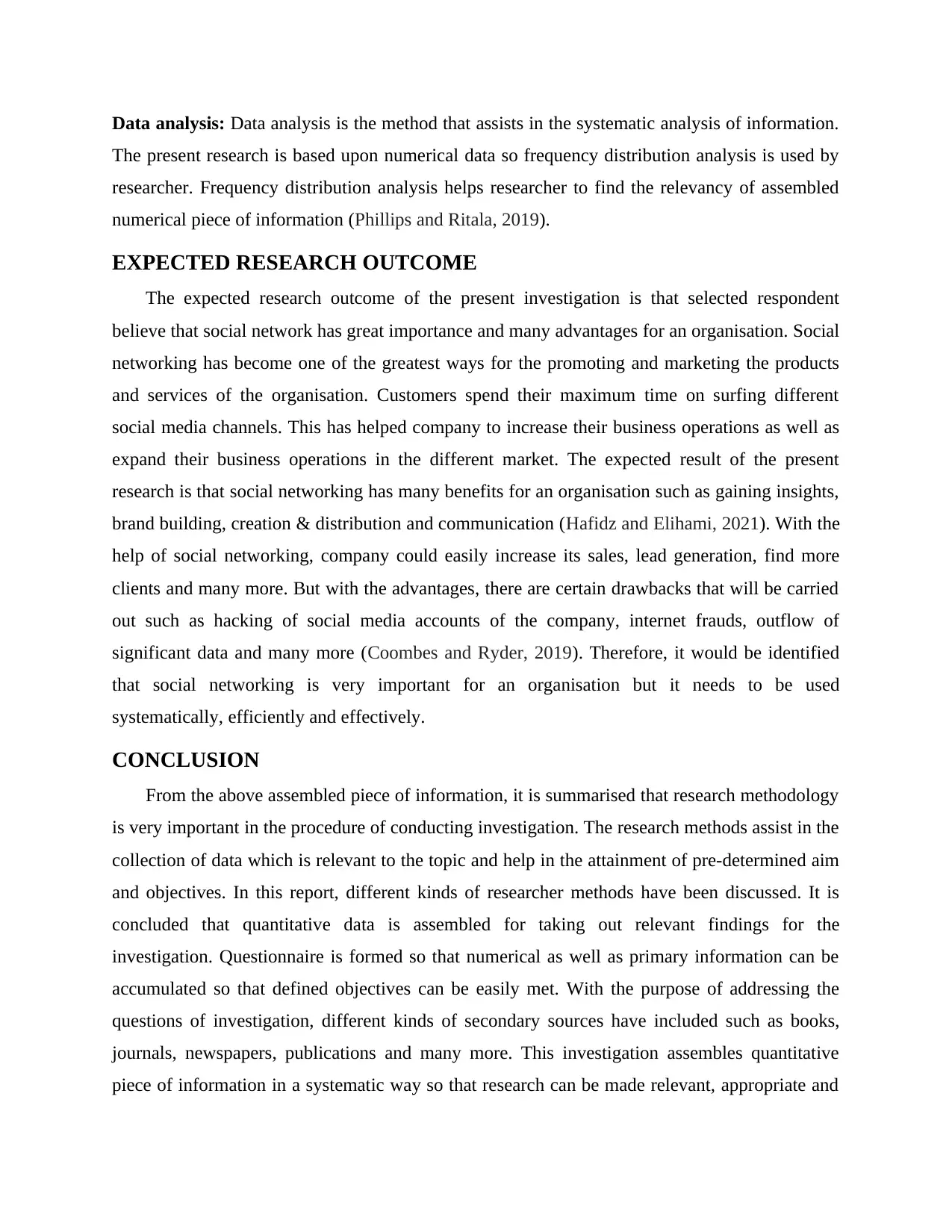
Data analysis: Data analysis is the method that assists in the systematic analysis of information.
The present research is based upon numerical data so frequency distribution analysis is used by
researcher. Frequency distribution analysis helps researcher to find the relevancy of assembled
numerical piece of information (Phillips and Ritala, 2019).
EXPECTED RESEARCH OUTCOME
The expected research outcome of the present investigation is that selected respondent
believe that social network has great importance and many advantages for an organisation. Social
networking has become one of the greatest ways for the promoting and marketing the products
and services of the organisation. Customers spend their maximum time on surfing different
social media channels. This has helped company to increase their business operations as well as
expand their business operations in the different market. The expected result of the present
research is that social networking has many benefits for an organisation such as gaining insights,
brand building, creation & distribution and communication (Hafidz and Elihami, 2021). With the
help of social networking, company could easily increase its sales, lead generation, find more
clients and many more. But with the advantages, there are certain drawbacks that will be carried
out such as hacking of social media accounts of the company, internet frauds, outflow of
significant data and many more (Coombes and Ryder, 2019). Therefore, it would be identified
that social networking is very important for an organisation but it needs to be used
systematically, efficiently and effectively.
CONCLUSION
From the above assembled piece of information, it is summarised that research methodology
is very important in the procedure of conducting investigation. The research methods assist in the
collection of data which is relevant to the topic and help in the attainment of pre-determined aim
and objectives. In this report, different kinds of researcher methods have been discussed. It is
concluded that quantitative data is assembled for taking out relevant findings for the
investigation. Questionnaire is formed so that numerical as well as primary information can be
accumulated so that defined objectives can be easily met. With the purpose of addressing the
questions of investigation, different kinds of secondary sources have included such as books,
journals, newspapers, publications and many more. This investigation assembles quantitative
piece of information in a systematic way so that research can be made relevant, appropriate and
The present research is based upon numerical data so frequency distribution analysis is used by
researcher. Frequency distribution analysis helps researcher to find the relevancy of assembled
numerical piece of information (Phillips and Ritala, 2019).
EXPECTED RESEARCH OUTCOME
The expected research outcome of the present investigation is that selected respondent
believe that social network has great importance and many advantages for an organisation. Social
networking has become one of the greatest ways for the promoting and marketing the products
and services of the organisation. Customers spend their maximum time on surfing different
social media channels. This has helped company to increase their business operations as well as
expand their business operations in the different market. The expected result of the present
research is that social networking has many benefits for an organisation such as gaining insights,
brand building, creation & distribution and communication (Hafidz and Elihami, 2021). With the
help of social networking, company could easily increase its sales, lead generation, find more
clients and many more. But with the advantages, there are certain drawbacks that will be carried
out such as hacking of social media accounts of the company, internet frauds, outflow of
significant data and many more (Coombes and Ryder, 2019). Therefore, it would be identified
that social networking is very important for an organisation but it needs to be used
systematically, efficiently and effectively.
CONCLUSION
From the above assembled piece of information, it is summarised that research methodology
is very important in the procedure of conducting investigation. The research methods assist in the
collection of data which is relevant to the topic and help in the attainment of pre-determined aim
and objectives. In this report, different kinds of researcher methods have been discussed. It is
concluded that quantitative data is assembled for taking out relevant findings for the
investigation. Questionnaire is formed so that numerical as well as primary information can be
accumulated so that defined objectives can be easily met. With the purpose of addressing the
questions of investigation, different kinds of secondary sources have included such as books,
journals, newspapers, publications and many more. This investigation assembles quantitative
piece of information in a systematic way so that research can be made relevant, appropriate and
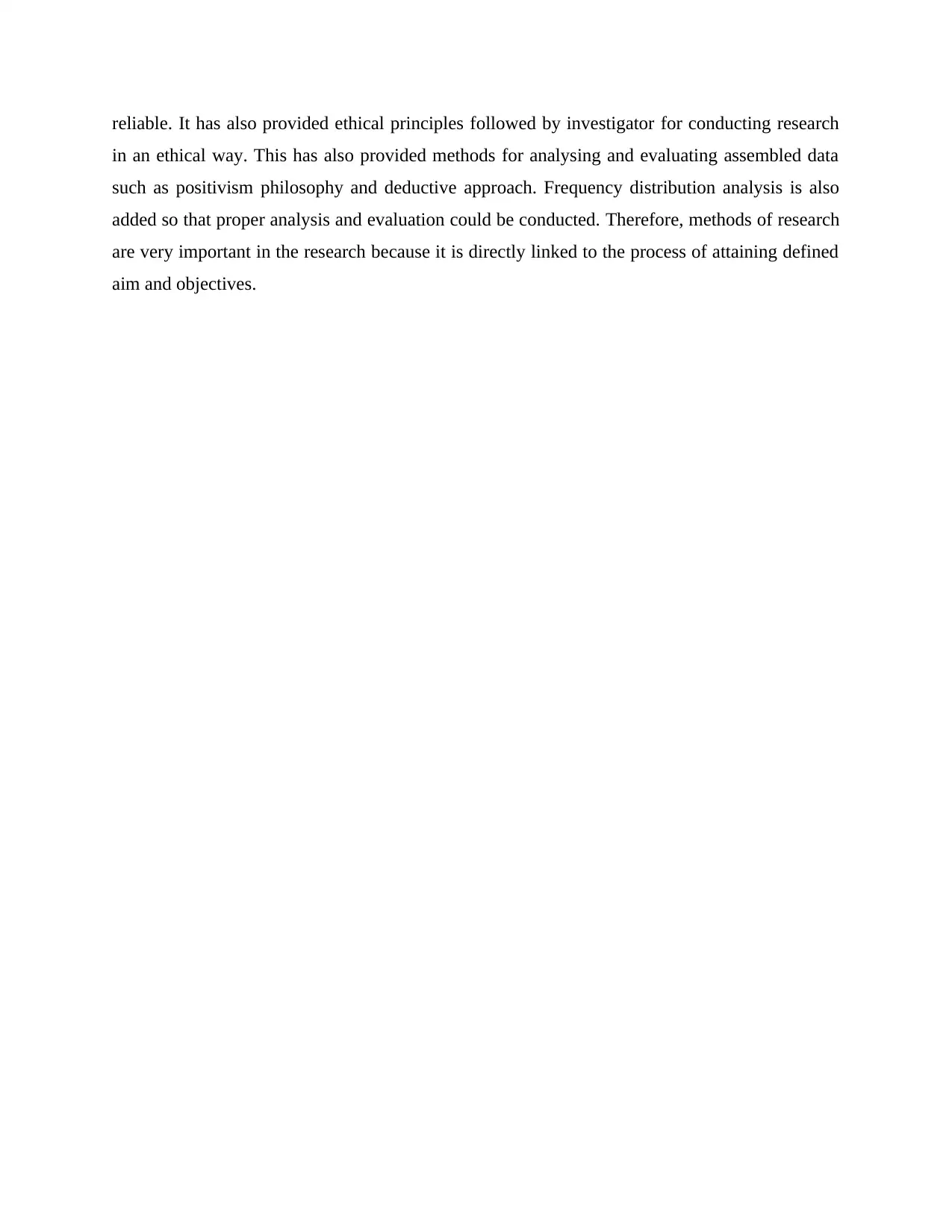
reliable. It has also provided ethical principles followed by investigator for conducting research
in an ethical way. This has also provided methods for analysing and evaluating assembled data
such as positivism philosophy and deductive approach. Frequency distribution analysis is also
added so that proper analysis and evaluation could be conducted. Therefore, methods of research
are very important in the research because it is directly linked to the process of attaining defined
aim and objectives.
in an ethical way. This has also provided methods for analysing and evaluating assembled data
such as positivism philosophy and deductive approach. Frequency distribution analysis is also
added so that proper analysis and evaluation could be conducted. Therefore, methods of research
are very important in the research because it is directly linked to the process of attaining defined
aim and objectives.
⊘ This is a preview!⊘
Do you want full access?
Subscribe today to unlock all pages.

Trusted by 1+ million students worldwide
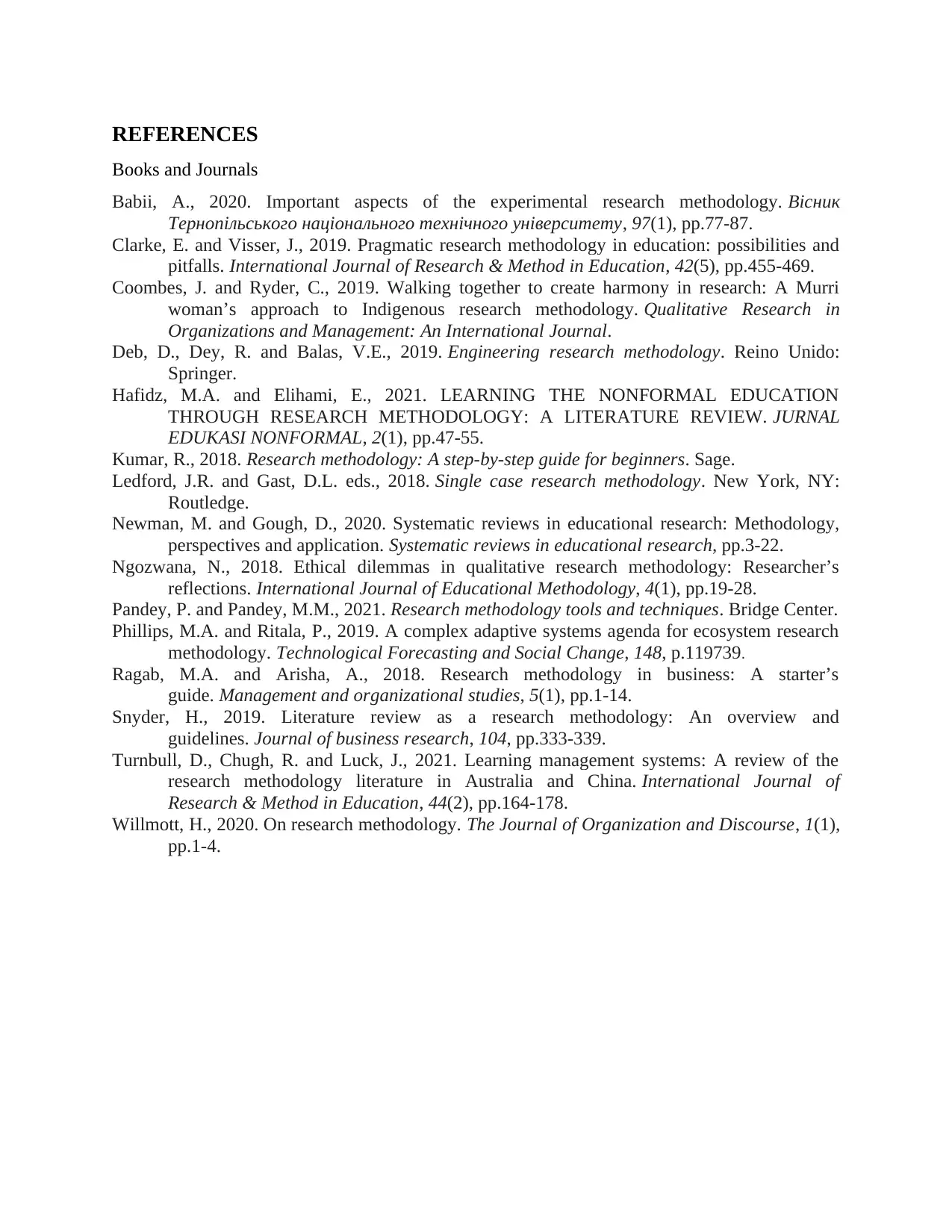
REFERENCES
Books and Journals
Babii, A., 2020. Important aspects of the experimental research methodology. Вісник
Тернопільського національного технічного університету, 97(1), pp.77-87.
Clarke, E. and Visser, J., 2019. Pragmatic research methodology in education: possibilities and
pitfalls. International Journal of Research & Method in Education, 42(5), pp.455-469.
Coombes, J. and Ryder, C., 2019. Walking together to create harmony in research: A Murri
woman’s approach to Indigenous research methodology. Qualitative Research in
Organizations and Management: An International Journal.
Deb, D., Dey, R. and Balas, V.E., 2019. Engineering research methodology. Reino Unido:
Springer.
Hafidz, M.A. and Elihami, E., 2021. LEARNING THE NONFORMAL EDUCATION
THROUGH RESEARCH METHODOLOGY: A LITERATURE REVIEW. JURNAL
EDUKASI NONFORMAL, 2(1), pp.47-55.
Kumar, R., 2018. Research methodology: A step-by-step guide for beginners. Sage.
Ledford, J.R. and Gast, D.L. eds., 2018. Single case research methodology. New York, NY:
Routledge.
Newman, M. and Gough, D., 2020. Systematic reviews in educational research: Methodology,
perspectives and application. Systematic reviews in educational research, pp.3-22.
Ngozwana, N., 2018. Ethical dilemmas in qualitative research methodology: Researcher’s
reflections. International Journal of Educational Methodology, 4(1), pp.19-28.
Pandey, P. and Pandey, M.M., 2021. Research methodology tools and techniques. Bridge Center.
Phillips, M.A. and Ritala, P., 2019. A complex adaptive systems agenda for ecosystem research
methodology. Technological Forecasting and Social Change, 148, p.119739.
Ragab, M.A. and Arisha, A., 2018. Research methodology in business: A starter’s
guide. Management and organizational studies, 5(1), pp.1-14.
Snyder, H., 2019. Literature review as a research methodology: An overview and
guidelines. Journal of business research, 104, pp.333-339.
Turnbull, D., Chugh, R. and Luck, J., 2021. Learning management systems: A review of the
research methodology literature in Australia and China. International Journal of
Research & Method in Education, 44(2), pp.164-178.
Willmott, H., 2020. On research methodology. The Journal of Organization and Discourse, 1(1),
pp.1-4.
Books and Journals
Babii, A., 2020. Important aspects of the experimental research methodology. Вісник
Тернопільського національного технічного університету, 97(1), pp.77-87.
Clarke, E. and Visser, J., 2019. Pragmatic research methodology in education: possibilities and
pitfalls. International Journal of Research & Method in Education, 42(5), pp.455-469.
Coombes, J. and Ryder, C., 2019. Walking together to create harmony in research: A Murri
woman’s approach to Indigenous research methodology. Qualitative Research in
Organizations and Management: An International Journal.
Deb, D., Dey, R. and Balas, V.E., 2019. Engineering research methodology. Reino Unido:
Springer.
Hafidz, M.A. and Elihami, E., 2021. LEARNING THE NONFORMAL EDUCATION
THROUGH RESEARCH METHODOLOGY: A LITERATURE REVIEW. JURNAL
EDUKASI NONFORMAL, 2(1), pp.47-55.
Kumar, R., 2018. Research methodology: A step-by-step guide for beginners. Sage.
Ledford, J.R. and Gast, D.L. eds., 2018. Single case research methodology. New York, NY:
Routledge.
Newman, M. and Gough, D., 2020. Systematic reviews in educational research: Methodology,
perspectives and application. Systematic reviews in educational research, pp.3-22.
Ngozwana, N., 2018. Ethical dilemmas in qualitative research methodology: Researcher’s
reflections. International Journal of Educational Methodology, 4(1), pp.19-28.
Pandey, P. and Pandey, M.M., 2021. Research methodology tools and techniques. Bridge Center.
Phillips, M.A. and Ritala, P., 2019. A complex adaptive systems agenda for ecosystem research
methodology. Technological Forecasting and Social Change, 148, p.119739.
Ragab, M.A. and Arisha, A., 2018. Research methodology in business: A starter’s
guide. Management and organizational studies, 5(1), pp.1-14.
Snyder, H., 2019. Literature review as a research methodology: An overview and
guidelines. Journal of business research, 104, pp.333-339.
Turnbull, D., Chugh, R. and Luck, J., 2021. Learning management systems: A review of the
research methodology literature in Australia and China. International Journal of
Research & Method in Education, 44(2), pp.164-178.
Willmott, H., 2020. On research methodology. The Journal of Organization and Discourse, 1(1),
pp.1-4.
1 out of 10
Related Documents
Your All-in-One AI-Powered Toolkit for Academic Success.
+13062052269
info@desklib.com
Available 24*7 on WhatsApp / Email
![[object Object]](/_next/static/media/star-bottom.7253800d.svg)
Unlock your academic potential
Copyright © 2020–2026 A2Z Services. All Rights Reserved. Developed and managed by ZUCOL.




